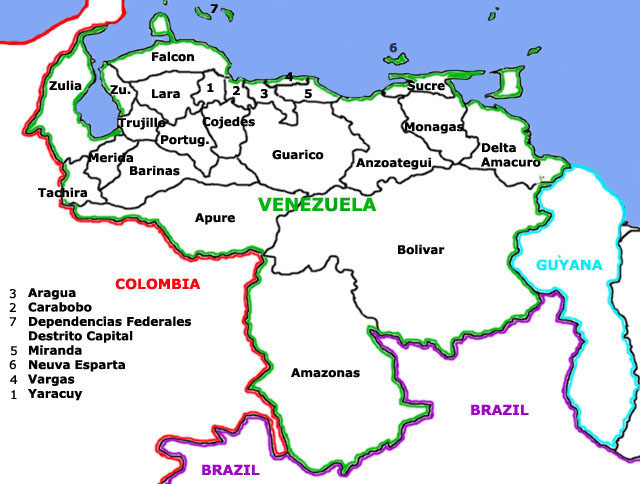Manduca: white apical patch on forewing; two rows of white dots on abdomen, white on juncture of thorax and abdomen; three yellow-orange marks on each
side of abdomen
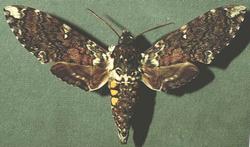
Manduca dalica dalica; 120-135mm:
Fw: dark, purplish-brown in median & subterminal areas.
Thin, black, very irregular aml inwardly traced in white, additional white along forewing base
& across thorax/abdomen juncture. Thin white line across head behind eyes.
Discal spot: large, white, connected by white triangular patch to suffusion on costal margin.
Whitish-grey apical patch, &
small, whitish mark anterior of anal angle. Space between 2nd & 3rd discal lines dark grey.
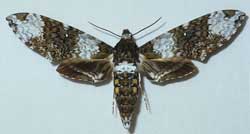
Manduca albiplaga:
Large white apical patch in upper half of postmedian area from outside of pm line to apex; another large white patch
from costa to inner margin just outside the basal area. Two white areas not contiuous as in rustica.
|
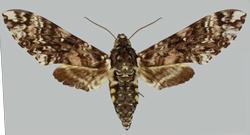
Manduca leucospila ; FWl: 47mm:
Space along i.m. between aml & post-discal lines: pale, suffused with buff.
Large greyish-white patches anterior to oblique apical line, and in submarginal area.
Smaller white patch & submarginal zigzag line near anal angle. Black streak connects 3rd antemedian & 1st discal
lines between veins CuA1 and CuA2; discal lines sharply dentate, 2nd and 3rd close together, with the space between spotted with white,
the lines more evenly curved than in Manduca rustica; fringe with white spots large, extending onto the wing membrane.
|
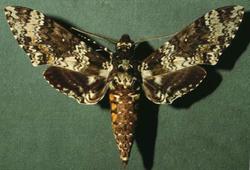
Manduca rustica
Broad, dominant U-shaped whitish area from costa (just outside am line) to inner margin; along inner margin
to last pm line and inside that line to first pm line to costa. Median area bounded by this shape is grey-brown with white cell and no
white triangle joining cell to costa. Lower inside 1/4 of basal area white with white marks above. Much white in terminal area.
Note inverted white v's, like eyebrows, over dark triangles on mid thorax. Strong white presence at juncture of thorax/abdomen.
|
Manduca: Conspicuous, dark band from about midpoint costa to outer margin near vein CuA1, housing white discal spot.
Plus unmistakable Manduca ochus.
|
|
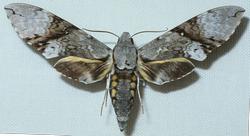
Manduca lefeburii :
Similar to Manduca andicola. Conspicuous,
diffuse, dark band from midpoint costa to outer margin near vein CuA1, housing white discal spot.
Mostly pale grey with pale brown triangular patch from cell spot to costa.
Aml weak, outer pm line weak.
No narrow black mesial line on abdomen upperside.
|
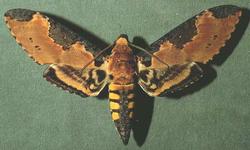
Manduca ochus
Unmistakable. Forewing costa charcoal grey with extensions into dominant tawny brown ground colour.
Two pairs of submarginal black dots and row
of marginal black spots on forewing upperside.
Head and thorax: tawny and orange.
Possibly ?? in northern Colombia
|
|
Manduca
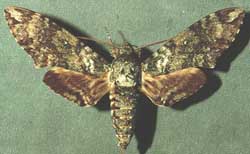
M. corallina
The white patch in forewing basal area seems characteristic of this species.
Thorax, especially in the male, seems less robust than in Manduca lichenea. Wings are more elongate than in Manduca lichenea, but with a very
similar pattern.
Inner postmedian line bends at almost exactly ninety degrees outside cell.
Outer margin with strong indentation just above anal angle.
|
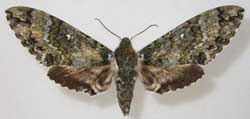
Manduca lichenea
Inner postmedian line bends at an obtuse angle (approximately 135 degrees) outside cell.
Cell mark is large and white, concave on outward facing egde.
Dark grey basal area, without strong presence of white along am line.
Outer margin without strong indentation just above anal angle.
|
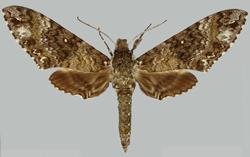
Manduca trimacula:
Body & forewing brownish-yellow, mottled with grey and tawny olive.
Abdomen: two rows of abdominal white dots; segments 1-3 with a yellow lateral patch bordered with black.
Inner postmedian line bends at an obtuse angle (approximately 150 degrees) outside cell.
Undulate and zigzag lines well-marked; discal and postdiscal lines curved as in Manduca sexta, the space between the 2nd and 3rd discal
lines white between veins Rs3 and Rs4, greyish white elsewhere; also greyish white on the distal side of the 3rd discal line; the space between the heavily-marked
1st and 2nd discal lines scarcely darker than the rest of the disc, not silky black as in Manduca lucetius; postdiscal line heavy, forming a patch on vein M3 and
behind CuA2, followed by a large, ill-defined, creamy white patch at vein M2 in post median area;
discal spot nearly white, round; oblique apical line heavy, with a creamy white border anteriorly
|
|
Manduca: Outer postmedian line in smooth S-shape on left forewing
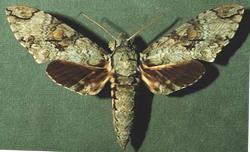
Manduca florestan
Fw gray to yellowish gray to brown with greenish tint in fresh specimens. Two black dashes running from below cell toward outer margin. Prominent reddish brown patch
outside cell, above dashes. Left fw pm lines: S-shaped, prominent for upper 3/4. Body side of black apical, trapezoid, oblique.
|
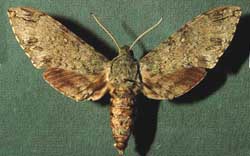
Manduca lanuginosa :
No yellow spots on the sides of the abdomen, gray shoulders, diffuse gray-brown "patternless" wing color, varying from quite dark brown to quite light gray.
Duller, with more uniform colouration than Manduca florestan. The side spots on the abdomen contain less black than in Manduca florestan.
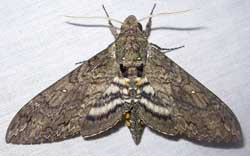
Manduca sexta paphus check distribution
|
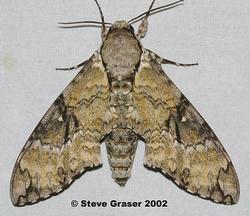
Manduca vestalis :
There is only one prominent, thin but distinct, S-shaped, post median line on the left forewing. The other "pmlines" are broadly diffuse.
Ground colour is light grey, often with a yellowish cast. There are two dark dashes below the cell and the upper half of the median area
is darker than the lower half.
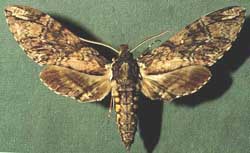
Manduca dilucida
|
|
++++++++
|
